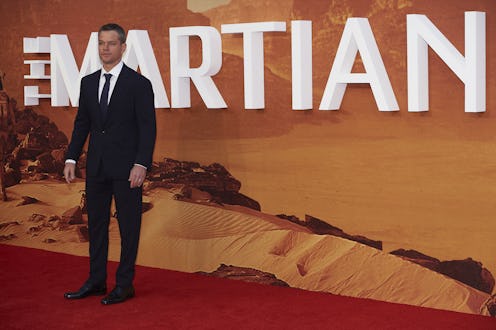Entertainment
'Martian' Space Travel Is Still A Distant Fantasy
The Martian wouldn't be possible without the fundamental premise that, one day, humans will reach Mars. Matt Damon's character Mark Watney becomes stranded on the planet after a sudden dust storm that forces his crew to evacuate Mars. Presumed dead, he's left to his own devices to figure out how to survive in a habitat bubble designed for only a month's use. In his words, "I'm going to have to science the sh*t out of this." But how realistic is the story? Could The Martian really happen?
If humans travel to Mars, then the possibility of the events in The Martian playing out seems pretty realistic. But that's a big if. See, in 1967, the world's dominant players in the Space Race, including the United States and the then-Soviet Union, signed a United Nations compact that they would not undertake exploration that had the possibility of contaminating either the local life or life on Earth by bringing back potentially harmful materials. And, according to Quartz, that includes water sources, which are particularly ripe for contamination. Still, the coincidental alignment of The Martian's release and NASA's announcement that there are signs of water on Mars indicate an ambition to explore beyond the Earth's limits.
So what are the most likely avenues of exploration? The UN treaty places pretty extensive geographical constraints on space travel, but that hasn't precluded various private companies from working towards their own missions to Mars alongside the existing NASA endeavors. There are unmanned rovers, manned scientific missions, and civilian sightseeing tours all in talks — and even in advanced stages of research and funding.
The Unmanned Mission Is Already Happening
Robots have traipsed around Mars for around 40 years now, both on the ground and in orbit around the planet. These include the two rovers Spirit and Opportunity, which landed to much applause in 2004. They're stocked with instruments to investigate for signs of water and though they're twins, the rovers explore different areas of the planet. More recently, the Mars Curiosity landed in 2012 after nearly a year of travel (it launched in 2011). Curiosity is charged with determining not only whether there are life-giving materials like water on Mars, but whether they're capable of sustaining life — the planet's "habitability." For example, in December the rover found traces of methane, the natural gas that is notably present in cow farts. Curiosity is on Twitter, and he (she? phe?) occasionally cracks Dune-related jokes.
The robot that recently gave indicators of water's presence on Mars is named the Mars Reconnaissance Orbiter — it didn't actually find water in substance, but something called recurring slope linae that might mean the ebb and flow of water as the seasons change. The upcoming Mars 2020 mission by NASA will explore the possibility that life not only could be on Mars (thanks, David Bowie), but that it already has been.
Unmanned Missions Might Pave The Way For Human Exploration
Mars 2020 isn't just a recon mission — it will also test out crucial technologies that would help humans survive on Mars when they finally launch into space. For example, MOXIE, which stands for "Mars Oxygen ISRU Instrument," will come along for the ride in an effort to convert atmospheric carbon dioxide into breathable oxygen.
In tandem with the remote exploration efforts, NASA has been perfecting its human transport technology. Less than a year ago, the administration launched Orion, which according to NASA is "the first spacecraft built for astronauts destined for deep space since the storied Apollo missions of the 1960s and 70s." According to the current schedule, astronauts will begin testing out manned flights at shorter distances beginning in 2020 and start heading for Mars around 2030.
Other aeronautics agencies have undertaken a similar effort — SpaceWorks, an Atlanta-based organization, proposes putting astronauts into torpor, a kind of stasis that would allow them to reach Mars as safely as possible. If this idea sounds familiar, it's because the same technology was used in Interstellar.
With Scientists Come Tourists
Private companies aren't only invested in pure scientific inquiry. A couple of firms have begun researching the possibility of placing tourists on the red planet. A nonprofit, the Inspiration Mars Foundation, has planned a fly-by mission for as soon as 2018. The organization is run by Dennis Tito, who, in addition to being fabulously wealthy, is perhaps better known as the first space tourist. (The retired NASA engineer tore into space with the Russians in 2001.) Virgin Galactic has a similar charter to Inspiration Mars, taking civilians to the planet, but with the additional plan to organize a colony of "a good cross-section of what happens on Earth," according to founder Richard Branson — that means "fun people, beautiful people, ugly people," he told the Huffington Post. But Branson's vision of a guided visit to Mars might not be in Virgin Galactic's immediate future. One of its spacecraft, SpaceShipTwo, crashed in 2014 during a test flight, killing its co-pilot (the pilot, miraculously, was only injured) and damaging the reputation of private chartered space flights.
Whatever the outcome of a manned Mars mission, one thing's (nearly) for sure — there won't be any reprisals of Laika, the Soviet dog launched into space to investigate the effects of space on earthly life forms.
Images: Giphy (5)
